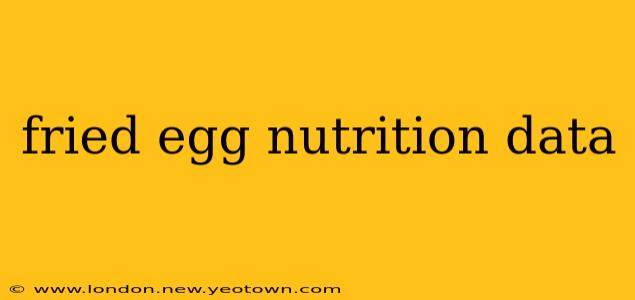The Sunny-Side Up Truth: A Deep Dive into Fried Egg Nutrition
Let's be honest, there's something undeniably comforting about a perfectly fried egg. That golden-brown crispiness, the runny yolk… it's a breakfast (or any-time-of-day) staple for many. But beyond the deliciousness, what's the nutritional story behind this culinary classic? This isn't just about calories; we'll explore the vitamins, minerals, and potential health impacts of incorporating fried eggs into your diet.
Imagine this: you're enjoying a plate of perfectly fried eggs, the aroma filling your kitchen. But what exactly are you consuming? This post delves into the detailed nutritional breakdown of a fried egg, addressing common questions and concerns.
How many calories are in a fried egg?
A large fried egg typically contains around 78 calories. However, this can vary slightly depending on the size of the egg and the amount of added oil or butter used during frying. Remember, the cooking method significantly impacts the final calorie count. A poached or boiled egg will have fewer calories than a fried egg, primarily due to the absence of added fat.
What are the macronutrients in a fried egg?
A fried egg is a decent source of protein and healthy fats, contributing to satiety and providing essential building blocks for the body. A large fried egg provides approximately:
- Protein: Around 6 grams. Protein is crucial for building and repairing tissues, making enzymes and hormones, and supporting a healthy immune system.
- Fat: Roughly 5 grams, mostly unsaturated fats. While some saturated fat is present, it's not excessively high. The type of oil used for frying, however, influences the fatty acid profile. Using olive oil, for instance, introduces beneficial monounsaturated fats.
- Carbohydrates: Negligible. Eggs are naturally low in carbohydrates.
What vitamins and minerals are in a fried egg?
Fried eggs are surprisingly nutrient-rich, especially when it comes to essential vitamins and minerals. A single serving offers a good dose of:
- Choline: This often-overlooked nutrient is vital for brain health, liver function, and cell membrane structure. Eggs are one of the best dietary sources of choline.
- Vitamin D: Important for calcium absorption, bone health, and immune function. The Vitamin D content can fluctuate based on the hen's diet and exposure to sunlight.
- Vitamin A: Crucial for vision, immune function, and cell growth. It's found in the yolk.
- Riboflavin (Vitamin B2): Involved in energy metabolism.
- Selenium: An antioxidant mineral that protects cells from damage.
Are fried eggs healthy?
The healthfulness of fried eggs depends heavily on how they're prepared. While they offer valuable nutrients, the added fat from frying can increase the overall calorie and saturated fat content. Opting for healthier cooking methods like poaching or boiling reduces the fat intake significantly. Furthermore, the type of oil used in frying plays a critical role. Using olive oil or avocado oil, rich in monounsaturated fats, is a healthier alternative to butter or heavily saturated oils.
How can I make fried eggs healthier?
Making healthier fried eggs is all about mindful choices:
- Use a cooking spray: This minimizes the amount of added fat.
- Choose healthy oils: Opt for olive oil, avocado oil, or other oils high in monounsaturated fats.
- Don't overcook: Overcooking can make the egg dry and less palatable. Aim for a runny or slightly firm yolk, depending on your preference.
- Control portion size: One or two eggs are usually sufficient for a meal.
What are the potential downsides of eating fried eggs?
While generally safe, some potential downsides to consuming fried eggs include:
- High cholesterol: Egg yolks are relatively high in cholesterol. However, recent research suggests the impact of dietary cholesterol on blood cholesterol levels is less significant than previously thought. Individuals with high cholesterol should still monitor their intake.
- High sodium content: If using salted butter or adding salt during cooking, sodium content can increase. This is a consideration for those on low-sodium diets.
- Potential for added fat and calories: The cooking method and type of fat used greatly influence the overall calorie and fat content.
In conclusion, fried eggs offer a good source of protein, healthy fats, and essential vitamins and minerals. However, mindful preparation and portion control are key to maximizing their nutritional benefits and minimizing potential downsides. Enjoying them as part of a balanced diet is usually perfectly fine for most people. So, go ahead and enjoy that fried egg – but do so with a little awareness!

